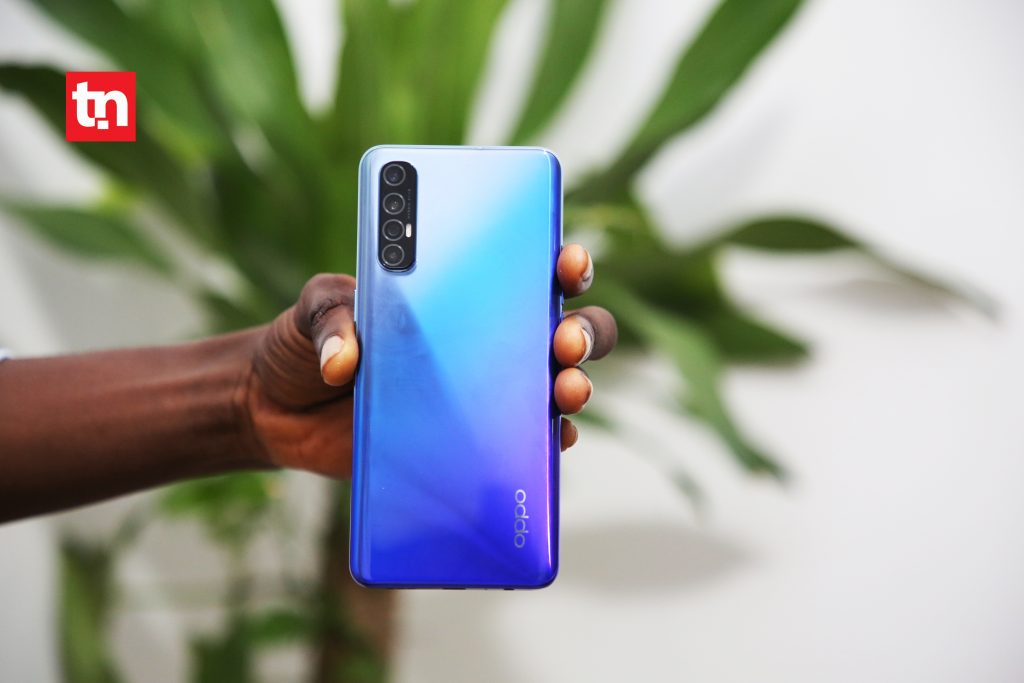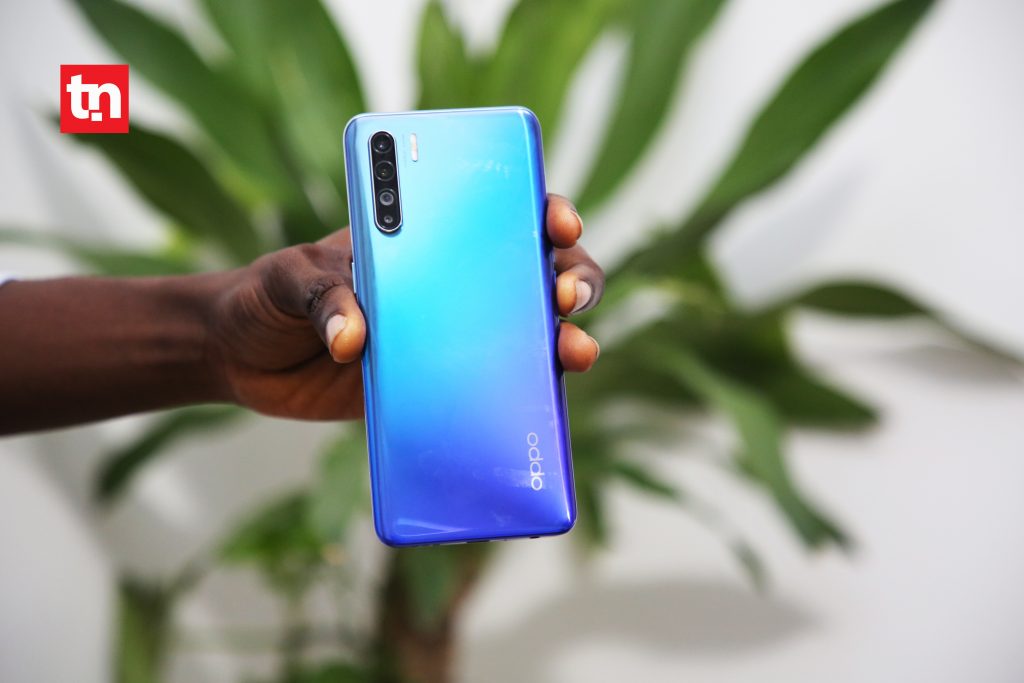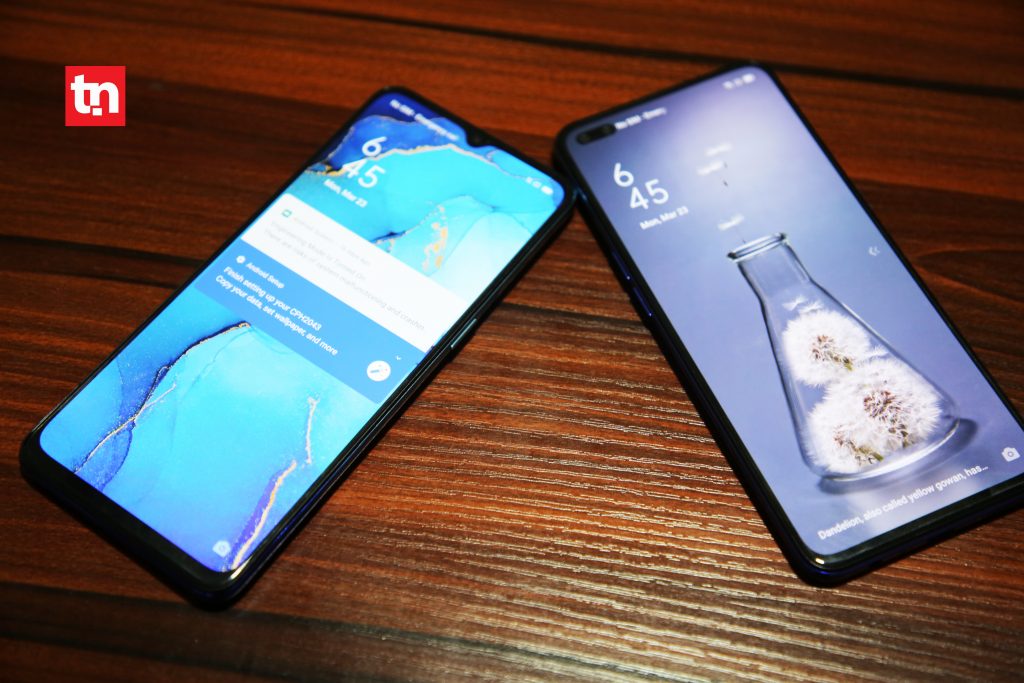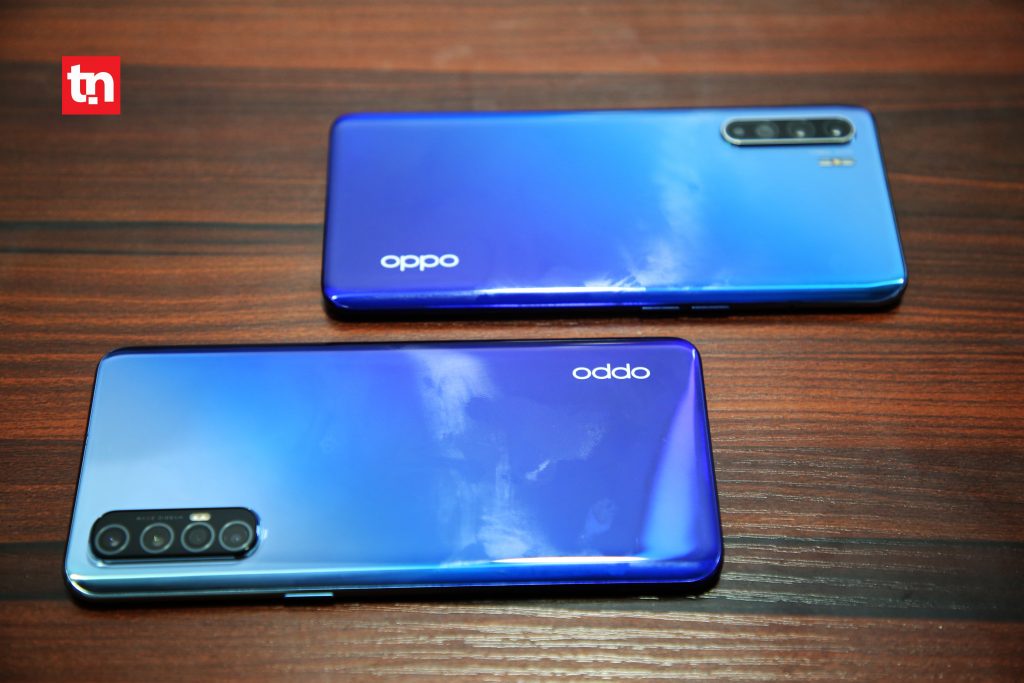Renowned OEM, OPPO has been serving its users with various models of its high tech smartphones. Of recent, the smartphone maker launched its latest contenders for the mid-range segment, the OPPO Reno 3 and Reno 3 Pro.
Although made available globally in March, they are yet to be launched officially in Nigeria. However, Technext took an up-close and personal look at the devices and here is what we can tell you about them.
Design
As usual with Oppo, the phones come with a sleek well-finished gradient colour on the back. The versions we received had the Auroral Blue gradient which makes the light dance on its surfaces. At first glance, one might think it’s made of glass. But it is actually made of polycarbonate – which means you are very likely to have your fingerprints over it in a jiffy.


On the back also, each phone has a bump that is the camera line up in a column off to one side with flashlights. At the front, unlike the Reno 2 and 2 Pro, Oppo ditched the rising front cameras for a cut-out in the Pro version and a notch in the regular version.


Both phones have Corning Gorilla Glass and are very comfortable to hold with a 6.25-inch screen for the Pro version and 6.3-inch screen for the Reno 3. The Pro version weighs 171 grams while Reno 3 weighs 10 grams more, which are both very handy.
The speakers are positioned at the bottom, which has become the new trend with recently released phones. This positioning has the advantage of ensuring you don’t lose out on the sounds if your phone is placed on a surface. The downside, however, is that it might be difficult for landscape use such as gaming and video streaming.


The USB Type-C port and 3.5mm microphone port are on the bottom as well. Power button highlighted by a green line is on the right, volume rockers are on the left as well as the duo sim card and expandable storage tray.
With a 2400×1080 resolution, the display is an impressive one, producing good colours that are vibrant although, in some scenarios, it might turn out a bit oversaturated sometimes.
Specs
Both phones pack an 8GB RAM (with a 12GB RAM variant) and 128GB ROM (with a 256GB ROM variant). They also allow for up to 512GB expandable memory card slot. The devices also have an on-screen fingerprint scanner and facial recognition for security which are both very fast.


For OS, the Reno 3 and 3 Pro both come with the latest Android 10 as well as the OPPO ColorOS 7 which offers better icons and overall interface. This ColorOS 7 comes with buffs the animation speed, all which makes it stand apart from previous versions of the ColorOS 7. Reno 3 comes with a MediaTek 1000L, 2.2GHz and 2.0GHz octa-core. The Reno 3 Pro comes with a 2.4GHz & 1.8GHz octa-core and Qualcomm Snapdragon 765G.
These do a good job of handling several memory-intensive apps simultaneously, although you might begin to experience a bit of lag after several apps. The smartphone also comes with a Game Space app that blocks notifications while gaming to improving performance.
On the battery side, they both pack 4025mAh, which boasts of over 24 hours during light usage and about 17 hours during heavy usage.
Camera
The Oppo Reno 3 and Reno 3 Pro both have four cameras. The Pro lineup consists of the main camera which is 64MP, a 13MP ultrawide sensor to take wide-angle images, an 8MP sensor for depth and 2MP Macro Camera for close up shots. The Reno 3 also has a similar lineup. The only differences are an 8MP ultrawide sensor and a 2MP depth sensor.
Oppo has also added a 108-megapixel camera option that uses up-scaling to capture a 108-megapixel image to capture enhanced quality photos.
On the front, the Reno 3 Pro packs a duo camera line up of 44MP wide-angle primary camera and a 2MP depth sensor. The Reno 3, on the other hand, has only a 44MP main camera.
Real-Life Performance
This camera set up allows it to have a great photography experience under wide range scenarios. Both OPPO devices are capable shooters in any lighting conditions. The main sensor cameras on both devices do an exceptional job of photography, especially under lit conditions thanks to the NPU on the processor that helps with the AI acceleration and AI Noise-reduction.
The colours in pictures turned out well saturated in most instances. The ultra-wide lens also handles pictures well.


The zooming capacity on both Oppo devices is also impressive. It can go up to 2x optical zoom, 5x hybrid zoom, and 20x digital zoom. This means it can take shots of things far away thanks to the 64MP Zoom Quadcam. However, shots might begin to lose details as you go farther.
The Ultra Dark mode works well enough. The mode churns out impressive images with adequate exposure, sharpness, and colours allowing you to capture the beauty in the dark. In some instances, colours might look a bit washed but it does nothing short of capturing those great moments. Another impressive lineup in the camera is the Macro mode. So if you are one that likes closeup images of nature and objects, these devices will do a very good job.
There are also other camera modes like the Expert mode and portrait mode that lets you take bokeh shots.
For selfies, the Reno 3 Pro does well to produce colours that are more accurate, although they might appear over smoothened in some cases. And for the Ultra Night Mode, it does a good job of providing brighter images while maintaining the glamour of the night.
The smartphone also supports 4K video recording at 30 frames per second. It packs the Ultra-Steady Video 2.0 software with Electronic Image Stabilization. One that can be combined with the ultra-wide camera to capture videos in the Ultra-Steady video Pro mode.
So when you are in the car, you can still capture great moments and not be bothered about blurry videos. Another key highlight of the smartphone is also the new video bokeh feature that allows users to blur the background even when recording videos.
In Conclusion
The Reno 3 and Reno 3 Pro both fall in the mid-range category and as such, one won’t expect them to match the strength of even the likes of Oppo’s Find X2 Pro. But in its own right, it is a top phone with its camera as a major selling point.
While a price hasn’t been set for the Nigerian market, on the global scene prices start from about $415 for Reno 3 and $450 for Reno 3 Pro.





